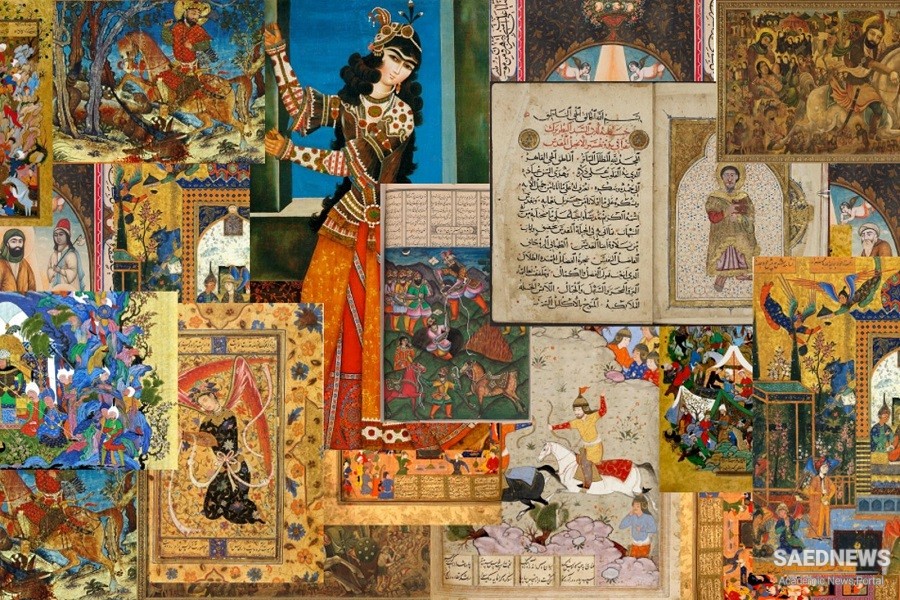Structures within compositions were typically stated without definition, though the terminology itself might offer insight into what defined different parts of a composition. The most commonly stated term for a distinct section of melodic development within a composition was khaneh (khāneh), which may or may not be further defined within the description of a particular form. In this way, Maraghi described the compositional form pishraw (pīshraw) as an instrumental piece with anywhere from two to fifteen khaneh, or two to fifteen distinct melodic sections. He implied that different khaneh may have melodies built upon different maqam, avaz, and sho‛beh, while also stating that ramal was one of the typical usul used in the composition of a pishraw. Maraghi stated that if someone added poetry to a melody of a khaneh from a pishraw and performed that song with the original usul of the pishraw, this type of song would be called a hava’i (havā’ī).
Conversely, he used the term qawl (qawl) to refer to any singing done in Arabic, whether set in musical meter without a specific poem in mind or sung with a known poem with reference to the poem’s specific poetic meter. The preeminent suite organization described by Maraghi was the nawbat murattab, which was a suite of songs that began with a qawl, followed by a ghazal (ghazal): a song sung in Persian and organized according to the same rhythmic as the opening qawl. The ghazal would be followed by a tarāneh, which was a song that could be sung in either Arabic or Persian, but it had to use poetry organized in quatrains (ruba’i) and use an usul that facilitated the phrasing of quatrains. The nawbat murattab ended with a song form called foru dasht (furū dasht), which Maraghi simply described as a song in Arabic. Unlike the more general term qawl, the foru dasht was a specific type of Arabic song that only appeared at the end of the nawbat murattab and served as a closing section of the entire suite.
Most compositional forms were songs that were partially defined by the language and poetry they used with implications for the rhythmic cycles they could accommodate. Even with rhythm being a primary consideration, they could still also have complex melodic organizations. Thus Maraghi described a song form sung in Persian called ‛amal (‛amal), which had its own specific progression of sections: first an introductory section he called motla’ (moṭla‛), then a middle section he referred to as sawt (sawt) or miyan khaneh (mīyān khāneh), and finally a concluding melodic section he referred to as both tashiyeh (tashīyeh) and baz gasht (bāz gasht).
While there are variations in descriptions of compositional forms within the twelve-maqam system from the fifteenth and sixteenth centuries, their descriptions are relatively consistent until the seventeenth century. References to some compositional forms within the twelve-maqam system disappear in the seventeenth century, including the nawbat murattab. A generally defined pishraw instrumental form remained, while song forms were added and redefined. While Persian writings on the twelve-maqam before the seventeenth century alternated between Arabic and Persian terms for sections of compositions, treatises of the seventeenth-century Safavid Empire employed a fairly standardized Persian terminology. This included references to primary melodic sections (sar khāneh), the middle or secondary melodic section (mīyān khāneh), and final sections that could be alternately referred to as recapitulations or reprises (bar gasht), or codas (ẕayl). In addition to these defined melodic sections, Safavid song forms using the twelve-maqam system were also defined by whether or not they started with poetry (ash‛ār) or “hits” (naqarāt). Sections of hits had no words, and the usul alone defined the music’s rhythm without poetry. In sections of hits the voice sang on a system of vocables rather than poetry.
The placement of sections of hits and sections of poetry in songs was key in defining Safavid compositional forms, even as sar khaneh, miyan khaneh, and bar gasht/zayl were also part of defining form. For instance, a previously general term for any musical composition, kar (kār), became a Safavid term for a specific form that started with a section of hits, followed by poetry and then another section of hits. Yet a kar’s actual form contained two sar khaneh, which were then followed by a miyan khaneh that had its own melodic development, which was then followed by a zayl or bar gasht. The term ‛amal (‛amal) came to denote the same structure of two sar khaneh, miyan khaneh and bar gasht, only it began starting with poetry rather than a section of hits. It appears that both sar khaneh usually began with either a section of hits or poetry in order to define a form as either kar or ‘amal. What made the miyan khaneh section different was its completely different melodic development in comparison with the sar khaneh, and its ability to start with either a section of hits or poetry.


 The Reng
The Reng














































